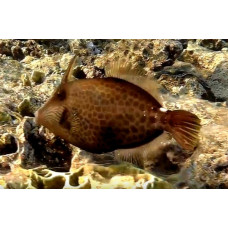Latin name
Cantherhines pardalis
Other name
Honeycomb leatherjacket, and wire-netting filefish.
Identification
Honeycomb filefish get their name from their rough, non-crossing scales with small spines on them. Their bodies are compressed at the sides and their eyes are set high and away from the mouth.
Features of fish fins
The dorsal fin is divided into two parts: the anterior part has two long curved spines, and the posterior part has thirty-two to thirty-six soft rays. The first dorsal spine is located just above the center of the eye, and the back of the fish has a deep groove into which the spine curls. The anal fin has no spines and consists of twenty-nine to thirty-two soft rays.
Fish colouring
This species has three basic types of coloration: uniform dark brown, mottled grayish brown, and gray ground color with a network of small polygonal markings. There is a conspicuous white spot at the base of the posterior part of the second dorsal fin and another at the base of the posterior part of the anal fins, which is a common feature of this species with the closely related C. pullus from tropical Atlantic reefs and C. sandwichiensis from Hawaii.
Distribution
Widespread in the Indo-Pacific: Red Sea south to South Africa and east to southern Japan and southeastern Oceania. Eastern Atlantic: Gulf of Guinea, Annobon Islands, southern coast of Africa. Replaced in Hawaii by Cantherhines sandwichensis.
Habitat
This fish lives in tropical marine waters around reefs. It is usually found at depths of up to 20 meters (66 feet), sometimes deeper.
Size
This fish can reach 25 centimeters (9.8 inches) in length, but its normal length is about 15 centimeters (5.9 inches).
Behavior
It is a shy and reclusive fish that usually lives alone. Both juveniles and adults sometimes drift together with plants and algae, including on rafts of sargassum. During territorial disputes, males raise and lower the main dorsal fin as a warning signal to each other.
Food and feeding habits
Honeycomb filefish feed on benthic organisms. Studies in Japan have shown that they feed mainly on red algae, sponges and some mollusks.
Reproduction
The female finds a suitable spawning site and buries her whole body in the algae. The male clings to the female and fertilizes the eggs she lays. Laying eggs in poisonous algae reduces the likelihood of predation. Parents do not care for their offspring.
Fishing
The species is of minor commercial interest.
Relationship with a person
Harmless.
| Classification | |
| Phylum | Chordata |
| Class | Actinopterygii |
| Squad | Tetraodontiformes |
| Family | Monacanthidae |
| Genus | Cantherhines |
| Species | C. pardalis |
| Features | |
| Conservation status | Least Concern |
| Habitat | Pelagic |
| Life span, years | No information |
| Maximum body weight, kg | No information |
| Maximum length, cm | 25 |
| Sailing speed, m/s | No information |
| Threat to people | Edible |
| Way of eating | Bentophage |
Honeycomb filefish
Tags: honeycomb filefish



